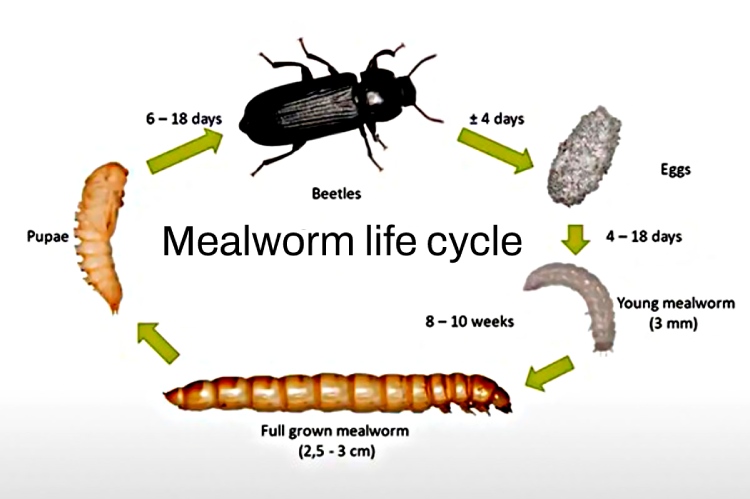Mealworm life cycle?
The mealworm life cycle consists of four stages: egg, larva, pupa, and adult. Eggs are laid by adult female mealworms and are extremely small, averaging about 0.25-0.5 mm in diameter. Once laid, the eggs will hatch after 7-10 days, depending on the temperature and humidity. The mealworm larvae or ‘worms’ are legless and white in color.
Mealworm life cycle time.
They will molt several times as they grow, eventually reaching a maximum size of 25-30 mm in length. After about 4-6 weeks, the larvae will begin to pupate, burrowing into the substrate or bedding material.
The pupal stage will last another 2-3 weeks, at which time the adult beetle emerges. Adult mealworms are dark brown in color and have wings, although they cannot fly. The adult female mealworms will live for approximately 4-6 months and lay hundreds of eggs during this time. The entire mealworms life cycle takes an average of 4-5 months to complete. Read here for what do mealworms turn into.
From Crunchy Critters to Wriggly Wonders: The Fascinating Journey of the Mealworm Life Cycle!
Mealworms have been gaining popularity as a sustainable source of protein in many parts of the world. But have you ever wondered how they come into being before they end up on your plate?
Join us as we explore the intriguing mealworm life cycle, from egg to pupa to fully-grown beetle. Discover the challenges and milestones that this tiny creature must overcome to reach maturity, and the fascinating transformations that take place along the way.
Mealworm life cycle: Eggs, The Starting Point
For the mealworm life cycle to begin, a female darkling beetle must lay her eggs on a suitable surface. These eggs are pale yellow in color and oval-shaped, measuring around 1mm in length.
The eggs take between 4 to 19 days to hatch, depending on the temperature and humidity levels. The ideal temperature range for hatching mealworm eggs is between 26-32°C, and the humidity level should be around 70-80%.
Life cycle of a mealworms: Larvae, The Crunchy Critters
Once the eggs hatch, the larvae emerge. These are what we recognize as mealworms – small, thin, and worm-like in appearance. The larvae feed voraciously on any organic matter they can find, such as dry leaves, cereals, and other insects.
The larvae go through a series of molts as they grow, each time shedding their old skin to reveal a new one underneath. During this process, the mealworm’s body takes on a more whitish hue.
Pupa: The Wriggly Wonders
After a few weeks of feeding, the larvae enter the pupal stage of their life cycle. During this time, the mealworm stops eating and becomes immobile, forming a pupa case around themselves.
Inside the pupa case, the mealworm undergoes a radical transformation. Its body reorganizes itself, and it metamorphoses into an adult darkling beetle.
Mealworm pupa are the intermediate life stage of darkling beetles, which are widely used as a source of food for reptiles, chickens, amphibians, birds, and fish. They are small, cream-colored, segmented larvae that can reach lengths of up to 1 inch. As they mature, the pupa develops hard brown shells that protect the developing insect’s body.
Mealworm pupa are high in protein and are a great source of vitamins and minerals. They can be found in pet stores, feed stores, and online. Mealworm pupae can be used as live food or frozen and used later. When fed to animals, they should be crushed, to provide easier access to the nutrients. Mealworm pupae are also used in agricultural and scientific research.
Their pupal stage makes them ideal for studying life cycles, metamorphosis, and genetics. They are also used to study microbial and fungal diseases, to supplement diets in animal experiments, and as an ingredient in animal food. Mealworm pupae are a highly nutritious food source and a great way to provide variety to a pet’s diet.
Mealworm life cycle: Adults, The Final Stage
After a week or two in the pupal stage, the darkling beetle emerges fully-grown from its pupa case. Unlike the larvae, the adult beetle can’t eat dry food; instead, it requires fresh fruits and vegetable scraps and often happily nibbles on these selections.
The life span of a beetle lasts for around six months, during which they mate and lay eggs to begin the mealworms life cycle anew.
Which Organism Has the Same Life Cycle Stages as a Mealworm?
If you have ever asked yourself which organism has the same life cycle stages as a mealworm, the answer lies in understanding insect development. A mealworm is the larval stage of the darkling beetle (Tenebrio molitor). Its life cycle includes egg, larva, pupa, and adult, a process known as complete metamorphosis. This same pattern is shared by many other insects.
For example, the butterfly follows identical stages: it begins as an egg, hatches into a caterpillar (larva), forms a chrysalis (pupa), and finally emerges as an adult butterfly. Similarly, beetles, ants, and bees also experience complete metamorphosis, making them organisms with the same life cycle structure as a mealworm.
Understanding which organism has the same life cycle stages as a mealworm is valuable for students, educators, and hobbyists who raise insects for study or pet food. Recognizing these shared stages helps explain how different species adapt and survive in nature.
In short, many insects—especially butterflies, beetles, ants, and bees—share the same four life cycle stages as a mealworm, demonstrating the fascinating diversity of complete metamorphosis in the insect world.
Conclusion
The mealworm life cycle is a fascinating journey full of incredible transformations and challenges. The next time you encounter these crunchy critters, remember how much they’ve gone through to reach your plate and appreciate the complex processes that make sustainable insect farming possible. Happy crunching!








